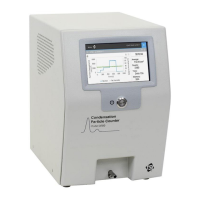4-8 Model 3750 Condensation Particle Counter
Drain i n g B utanol f r om the R e s e rvoir
Butanol must be drained from the reservoir prior to removing the saturator
wick or shipping the CPC. To drain the butanol reservoir:
1. Connect butanol drain bottle to the drain fitting on the back of the CPC.
2. Place the drain bottle on the floor.
3. Enable the drain on the Settings Screen of the instrument User
Interface.
4. The butanol drain valve will open. Often there is not a significant
column of liquid in the butanol drain line to start the flow from the
butanol reservoir. Tipping the instrument toward the drain port and/or
squeezing the butanol bottle can help to start flow.
5. A special vacuum drain bottle cap is provided in the accessory kit to
facilitate butanol draining using a vacuum source. The cap consists of
a vacuum port and a Balston filter. The Balston filter provides a bypass
flow path. Connect the external vacuum source to the vacuum port.
Connect the drain line to the Drain port on the CPC. When drain valve
is open and vacuum is applied, the vacuum helps to pull excess
butanol from the internal butanol reservoir and the wick. Exhaust from
the external vacuum source contains butanol vapor and must be
directed away from work spaces.
6. If the CPC is going to be shipped, it is necessary to dry the saturator
wick after draining butanol from the reservoir. To do so, leave the CPC
running with Flow enabled for approximately 24 hours.
Note: During draining, the Auto Fill and Flow are automatically disabled.
When draining is stopped, Flow and Auto Fill must be manually re-
enabled.
Moving and S h i p p i ng t he C P C
Make sure the CPC is turned off and remains upright when moving the
instrument. There is no need to drain the CPC before moving it a short
distance. Prior to shipping, however, it is necessary to drain butanol from
the instrument. Refer to “Draining Butanol from the Reservoir” above to
drain the CPC.
TSI recommends that you keep the original packaging (carton and foam
inserts) of the CPC for use whenever the CPC is shipped, including when it
is returned to TSI for service. Always seal off the sampling inlet with a cap
or tape to prevent debris from entering the instrument and drain and dry
the CPC before shipping.

